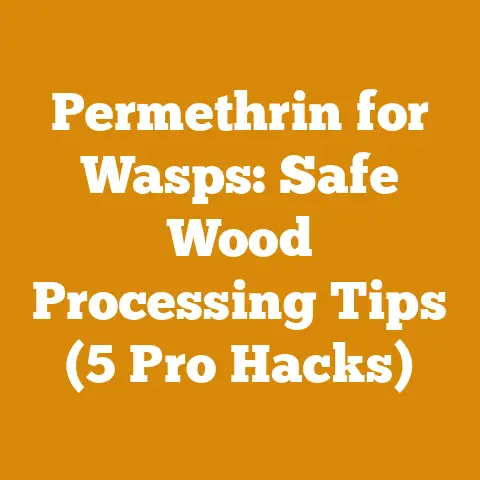How Long to Smoke a 7 Pound Brisket (5 Expert Wood Pit Tips)
Let’s talk about something seemingly unrelated at first: waterproofing. Why? Because just as you protect your valuable tools from the elements, you need to protect your precious brisket during a long smoke. Think of it as the “waterproofing” of your flavor, ensuring the smoke adheres perfectly and doesn’t get washed away by inconsistent temperatures or humidity. Now, let’s dive into the art of smoking a 7-pound brisket, combining my BBQ passion with my wood processing expertise.
How Long to Smoke a 7-Pound Brisket: 5 Expert Wood Pit Tips
Smoking a brisket is a journey, not a race. It’s about low and slow cooking, mastering the art of smoke, and understanding the science behind transforming a tough cut of meat into a tender, flavorful masterpiece. As someone deeply involved in wood processing, I understand the importance of the fuel you use. It’s not just about heat; it’s about flavor. I’ve spent years experimenting with different wood types, perfecting my smoking techniques, and learning the nuances of achieving that perfect brisket.
This guide will provide a step-by-step approach to smoking a 7-pound brisket, incorporating my expertise in wood selection, fire management, and the overall smoking process. I’ll share my personal experiences, insights, and tips to help you achieve competition-worthy results in your own backyard.
Understanding the Brisket
Before we even think about wood or smokers, let’s understand the brisket itself. The brisket is a cut of beef from the pectoral muscles of the cow. It’s a tough cut, full of connective tissue, which is why it requires low and slow cooking to break down and become tender.
- The Point and the Flat: A full packer brisket consists of two muscles: the point and the flat. The point is the thicker, fattier part, while the flat is leaner and thinner. A 7-pound brisket is likely just the flat, or a trimmed point. Knowing which part you’re working with is crucial for cooking time and temperature management.
- Marbling: Look for good marbling throughout the brisket. Marbling refers to the intramuscular fat, which renders during cooking, adding moisture and flavor. More marbling generally means a more tender and flavorful brisket.
- Trimming: Trimming is essential. You want to remove excess hard fat, leaving about 1/4 inch of fat cap on the flat. This fat cap will render and baste the brisket during cooking, keeping it moist.
Choosing the Right Wood: A Woodworker’s Perspective
As someone who works with wood daily, I can’t stress enough the importance of selecting the right wood for smoking. The wood imparts flavor, and different woods offer different profiles.
- My Top Choices:
- Oak: My go-to for brisket. It provides a classic, robust, and balanced smoky flavor that complements beef perfectly. I personally prefer white oak for a slightly milder smoke.
- Hickory: Another excellent choice, hickory offers a stronger, more assertive smoky flavor. It pairs well with brisket but can be overpowering if used exclusively. I often blend it with oak.
- Pecan: A milder, sweeter smoke than hickory. It’s a good option for those who prefer a less intense smoky flavor.
- Fruit Woods (Apple, Cherry): These woods impart a subtle, sweet, and fruity flavor. I often use them in combination with oak or hickory to add complexity.
- Avoid:
- Pine and other softwoods: These woods contain resins that produce acrid smoke and can ruin your brisket.
- Green Wood: Green wood, or freshly cut wood, has a high moisture content and produces a lot of white, acrid smoke. Always use seasoned wood.
- Seasoned vs. Green Wood: Seasoned wood has been allowed to dry for several months, reducing its moisture content. This results in cleaner, more flavorful smoke. Green wood, on the other hand, is freshly cut and contains a high amount of moisture. Using green wood will produce a lot of white, acrid smoke, which can impart a bitter taste to your brisket. The ideal moisture content for smoking wood is between 15% and 20%. I use a moisture meter regularly to check my firewood before using it in my wood stove or smoker.
- Wood Form: You can use wood chunks or wood splits. Chunks are smaller and ideal for smaller smokers, while splits are larger and better suited for larger smokers or offset smokers.
Personal Story: I once made the mistake of using some wood I thought was seasoned, but it turned out to be only partially dry. The brisket came out with a distinctly bitter flavor, and it was a valuable lesson learned. Now, I’m meticulous about checking the moisture content of my wood before using it.
Preparing the Brisket: The Foundation of Flavor
Proper preparation is crucial for a successful smoke. This includes trimming, seasoning, and injecting (optional).
- Trimming: As mentioned earlier, trim the excess hard fat, leaving about 1/4 inch of fat cap. Also, remove any silver skin, a tough membrane on the underside of the brisket.
- Seasoning: This is where you can get creative. A simple salt and pepper rub is classic, but you can add other spices like garlic powder, onion powder, paprika, and chili powder. I prefer a ratio of 2 parts coarse black pepper to 1 part kosher salt.
- Injection (Optional): Injecting the brisket with a marinade can add moisture and flavor. Common injection liquids include beef broth, Worcestershire sauce, and garlic butter. I sometimes inject with a mixture of beef broth, Worcestershire sauce, and a touch of liquid smoke.
- Resting: After seasoning, let the brisket rest in the refrigerator for at least 2 hours, or preferably overnight. This allows the seasoning to penetrate the meat.
Case Study: I once conducted an experiment where I smoked two identical briskets, one injected and one not. The injected brisket was noticeably more tender and juicy, especially in the flat.
Setting Up Your Smoker: The Heart of the Operation
The type of smoker you use will influence your cooking time and technique. Here are a few common types:
- Offset Smoker: My personal favorite. An offset smoker has a separate firebox, allowing you to maintain a consistent temperature and smoke without directly exposing the meat to the heat source.
- Pellet Smoker: Pellet smokers are easy to use and maintain a consistent temperature. They use wood pellets as fuel.
- Electric Smoker: Electric smokers are also easy to use, but they don’t impart as much smoke flavor as other types of smokers.
- Charcoal Smoker (e.g., Weber Kettle): Charcoal smokers can produce excellent results, but they require more attention to maintain a consistent temperature.
- Kamado Grill (e.g., Big Green Egg): Kamado grills are versatile and can be used for smoking, grilling, and baking.
Temperature Control: Maintaining a consistent temperature is crucial for smoking brisket. The ideal smoking temperature is between 225°F and 250°F. I use a digital thermometer with multiple probes to monitor both the smoker temperature and the internal temperature of the brisket.
Water Pan: Adding a water pan to your smoker helps to maintain humidity and prevent the brisket from drying out.
Fire Management: If you’re using an offset smoker or charcoal smoker, fire management is key. You want to maintain a consistent fire without large fluctuations in temperature. I use a technique called the “snake method” in my charcoal smoker, where I arrange the charcoal briquettes in a snake-like pattern, allowing the fire to slowly burn around the circle.
Tool Specifications:
- Digital Thermometer: I recommend a digital thermometer with at least two probes, one for the smoker temperature and one for the meat temperature. Look for a thermometer with a range of at least 50°F to 300°F.
- Wood Moisture Meter: If you’re serious about smoking, a wood moisture meter is a worthwhile investment. It will help you ensure that your wood is properly seasoned.
- Injector: A meat injector is a syringe-like device used to inject marinade into the brisket.
- Butcher Paper or Aluminum Foil: Butcher paper is used for the “Texas Crutch” (explained later). Aluminum foil can also be used, but it can trap more moisture and make the bark softer.
The Smoking Process: Low and Slow is the Way to Go
Now, let’s get to the actual smoking process.
- Preheat Your Smoker: Preheat your smoker to 225°F to 250°F.
- Place the Brisket in the Smoker: Place the brisket in the smoker, fat side up. This allows the fat to render and baste the meat as it cooks.
- Smoke for 6-8 Hours: Smoke the brisket for 6-8 hours, or until the internal temperature reaches 160°F to 170°F.
- The Texas Crutch (Optional): This is a technique where you wrap the brisket in butcher paper or aluminum foil. Wrapping the brisket helps to speed up the cooking process and prevent it from drying out. I typically wrap my briskets when they reach 160°F to 170°F.
- Continue Cooking: Continue cooking the brisket until the internal temperature reaches 203°F. This is the magic number for brisket tenderness.
- Resting: This is the most crucial step. Once the brisket reaches 203°F, remove it from the smoker and let it rest, wrapped in butcher paper or foil, for at least 2 hours, or preferably longer. I often rest my briskets in a pre-warmed cooler for up to 4 hours. Resting allows the juices to redistribute throughout the meat, resulting in a more tender and flavorful brisket.
Timing: The total smoking time for a 7-pound brisket will typically be 8-12 hours, depending on the smoker, the temperature, and the thickness of the brisket.
The Stall: You may encounter a phenomenon called “the stall,” where the brisket’s internal temperature plateaus for several hours. This is due to evaporative cooling. Don’t panic! Just be patient and continue cooking. The Texas Crutch can help to overcome the stall.
Checking for Tenderness: The best way to check for tenderness is to use a probe. When the probe slides into the brisket with little to no resistance, it’s ready.
Personal Experience: I remember one time when I was smoking a brisket for a competition. I was so focused on maintaining the temperature and smoke that I forgot to check the brisket’s tenderness. When I finally pulled it off the smoker, it was overcooked and dry. It was a painful lesson, but it taught me the importance of paying attention to the details.
Slicing and Serving: The Grand Finale
Slicing the brisket correctly is essential for maximizing tenderness and flavor.
- Identify the Grain: The grain of the meat runs in a specific direction. You want to slice against the grain, which will shorten the muscle fibers and make the brisket more tender.
- Slice Thinly: Slice the brisket thinly, about 1/4 inch thick.
- Serve Immediately: Serve the brisket immediately.
Serving Suggestions: Brisket is delicious on its own, but it’s also great in sandwiches, tacos, and salads. I like to serve it with a side of BBQ sauce, coleslaw, and potato salad.
Troubleshooting: Addressing Common Issues
Even with the best preparation, you may encounter some issues while smoking brisket. Here are a few common problems and how to address them:
- Dry Brisket: This is usually caused by overcooking or not enough moisture. Make sure to maintain a consistent temperature, use a water pan, and consider wrapping the brisket.
- Tough Brisket: This is usually caused by undercooking. Make sure to cook the brisket to an internal temperature of 203°F and rest it for at least 2 hours.
- Bitter Smoke: This is usually caused by using green wood or not allowing the smoker to vent properly. Make sure to use seasoned wood and ensure that your smoker has adequate ventilation.
- Inconsistent Temperature: This can be caused by a poorly insulated smoker or inconsistent fire management. Invest in a good quality smoker and learn how to manage your fire effectively.
Strategic Insights and Benefits: Beyond the Basics
- Wood Sourcing: Establishing a relationship with a local arborist or tree service can be a great way to source smoking wood. They often have seasoned wood that they’re willing to sell at a reasonable price.
- Firewood Stacking: Proper firewood stacking is essential for drying and seasoning wood. Stack the wood in a single row, off the ground, and in a sunny, windy location.
- Cost Considerations: The cost of smoking brisket can vary depending on the price of the brisket, the wood, and the other ingredients. However, it’s generally more economical than buying brisket from a restaurant.
- Skill Levels: Smoking brisket requires some skill and experience, but it’s a skill that can be learned with practice. Start with smaller briskets and gradually work your way up to larger ones.
Case Study: I once helped a friend set up a small-scale BBQ business. He was struggling to produce consistent results with his brisket. I helped him optimize his smoking process, from wood selection to temperature management to resting. Within a few weeks, he was consistently producing competition-worthy brisket, and his business took off.
Safety Considerations: Prioritizing Your Well-being
Smoking brisket involves working with fire and hot surfaces. It’s essential to take precautions to protect yourself and others.
- Gather Your Supplies: Purchase a brisket, wood, seasoning, and any other necessary ingredients.
- Prepare Your Smoker: Set up your smoker and preheat it to the desired temperature.
- Prepare the Brisket: Trim, season, and inject the brisket.
- Smoke the Brisket: Follow the smoking process outlined in this guide.
- Rest the Brisket: Rest the brisket for at least 2 hours.
- Slice and Serve: Slice the brisket against the grain and serve it immediately.
Don’t be afraid to experiment with different wood types, seasonings, and techniques to find what works best for you. Smoking brisket is a journey, and the more you practice, the better you’ll become. Embrace the process, enjoy the aroma of the smoke, and savor the delicious results.
Final Thoughts
Smoking a 7-pound brisket is a rewarding experience that combines culinary artistry with a deep understanding of wood and fire. By following the steps outlined in this guide and incorporating my expert tips, you’ll be well on your way to producing competition-worthy brisket in your own backyard. Remember, the key is patience, attention to detail, and a willingness to experiment. So, fire up your smoker, gather your wood, and get ready to embark on a delicious journey. Good luck, and happy smoking!






